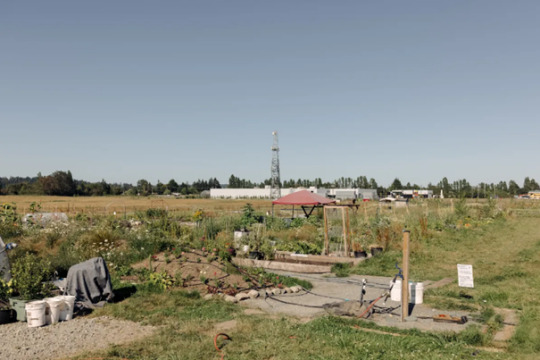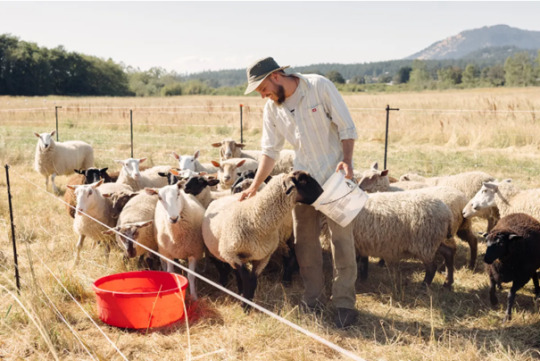#affordable arm land
Text
Vancouver Island (CDN) project aims to nurture next generation of farmers

Sandown Centre for Regenerative Agriculture, an 83-acre farm in North Saanich on Vancouver Island, opened in January, 2021.
Stephanie Jacobs spends her Saturdays knee-high in soil and manure, planting medicinal herbs in a quarter-acre plot that used to be the car park of a racetrack. This is the closest she has come to owning her own farm, something she has dreamed of since she was a child.
“Farming is my passion in life,” she said. “It connects me to the ecosystem in a larger way.” After looking for farming land near her home on Vancouver Island[1] for two years, she’d given up – land prices were far too high. Plus, even if she had been successful in her search, she wasn’t entirely sure she would be able to take the long, physically demanding days for such slim profits.
Then, she heard about Sandown. Sandown Centre for Regenerative Agriculture is a 83-acre farm in North Saanich on Vancouver Island[2]. It is located on an old racetrack, nestled in the shadow of Victoria Airport and downstream from an Amazon warehouse.

Ms. Jacobs works in the hot afternoon sun cutting yarrow flowers at Sandown.
The centre opened in January, 2021. It is a non-profit that is focused on regenerative agriculture – an eco-friendly approach that integrates livestock, removes tillage and uses crops that are good for the soil to sequester carbon and increase biodiversity.
But Sandown is also interested in fostering the next generation of farmers through what they call their farmpreneur program – an initiative that provides farmers with affordable land and the knowledge, support and community they need to become financially viable. The program helps them get started by leasing them plots for a fraction of what it would cost to purchase or lease land for a farm.
The economic challenges posed by farming stretch beyond Vancouver Island. According to the Canadian Agricultural Human Resource Council[3], 47 per cent of agricultural producers can’t find enough workers, leading to $2.9-billion in lost sales. This labour shortage is only getting worse. As of 2017, a quarter of farmers were set to retire by 2025. Simultaneously, 200,000 fewer young people were entering the industry.
“We are facing a shortage of farms and farmers primarily because new farmers cannot purchase land,” said Ms. Jacobs. “It is simply out of reach financially. The program at Sandown offers farmers an opportunity to access land at an affordable rate to start farming.”
Once in the program, the farmpreneurs are given help with marketing their produce, and research on how to best cultivate crops. They are also connected to the other farmpreneurs, and encouraged to foster a sense of community and camaraderie.
“We asked ourselves: ‘How do we incubate new farmers and support them to learn?’” said Lindsey Boyle, board member and co-founder at Sandown. “Not only on how to farm regeneratively – which is a climate solution and a way to grow better food – but how do we support farmers to learn in a way that’ll make them want to stick around?”
This means giving farmers guidance on how to make their operation financially viable. According to Ms. Boyle, selling produce is rarely enough, especially when competing with cheap imported goods, and especially when considering the huge upfront investment farming entails. For example, Ms. Jacobs has planted perennials such as raspberry bushes in her plot, the equivalent of a quarter of a football field. She will not reap the fruits of this investment for at least five years.
Ms. Boyle therefore argues that today’s farmers must think about multiple revenue streams. One short-term example would be to market farms as a wedding venue until they can make more money through farming. Other options are to teach agricultural students, and provide services such as consultations on soil health to the general public. Ms. Boyle would also like to see an agri-tourism sector fostered on the island.
“We call it farmpreneur because we want to fix this narrative that farming is a ton of work and that you’re barely scraping by,” said Ms. Boyle. “We really have to make it so people are well set up and supported to successfully run a business, which in many cases is more than just selling the food you grow.” But other options start at the roots. Sandown is researching the ways in which regenerative agriculture could be more financially viable in the long term.
Matthew Kyriakides is the manager of land resources at Sandown and a PhD student at the University of Victoria. Over the next few years, he will be working with 20 plots of degraded land, and will be using various techniques – some traditional and other regenerative – to see if he can bring the land back to health. He is hoping that the regenerative techniques will prove to be more successful, and more financially viable.

Matthew Kyriakides, manager of land resources at Sandown, will spend the next few years seeing if he can bring 20 plots of degraded land back to health.
While the traditional techniques will be straightforward – a single crop, placed into land that is tilled, and controlled via pesticides – the diversified techniques will use a combination of techniques. In some, the land will not be tilled, and in others, Mr. Kyriakides is using cover crops – specific crops grown for the protection and enrichment of soil – and animals, such as sheep, for weed and pest control. “I’m hoping I can find a win-win with this,” said Mr. Kyriakides. “And I feel quite confident that a diversified system will be the way to go.”
However, Ms. Boyle thinks that farmers won’t be truly financially successful until a larger, structural issue is tackled: supply chains. According to Ms. Boyle, the upfront costs of farming are huge and without a marketplace that offers stable, guaranteed prices for local produce, most would-be farmers simply won’t be able to justify the risk.
“We need a business model that will connect farmers to the people who need a secure supply of produce,” said Ms. Boyle. “We need them to forward-pay, to build relationships where those growers can trust that there is going to be a market for what they’re doing.”
Ms. Boyle thinks that this will allow local, regenerative growers to scale up, making agriculture more sustainable, both environmentally and financially. “We need to support financially to get to those bigger volumes,” said Ms. Boyle. “We need to provide that financial incentive so people won’t see this as a small-market niche.” When Ms. Jacobs thinks of the future, she also envisions an updated, more community-based agricultural industry, one that will support her, her family and their lifestyle moving forward. “I dream of being able to let my kids run into the field and eat raspberries until their bellies are full,” said Ms. Jacobs. “And then still have enough to be able to give to other people.”
Source
Kate Helmore, Vancouver Island project aims to nurture next generation of farmers, in: The Globe and Mail, 6-08-2022, https://www.theglobeandmail.com/canada/british-columbia/article-regenerative-agriculture-sandown/
[1] Vancouver Island is an island in the north-eastern Pacific Ocean and part of the Canadian province of British Columbia. The island is 456 km in length, 100 km in width at its widest point, and 32,134 km2 in area. The island is the largest by area and the most populous along the west coasts of the Americas. The southern part of Vancouver Island and some of the nearby Gulf Islands are the only parts of British Columbia or Western Canada to lie south of the 49th parallel. This area has one of the warmest climates in Canada, and since the mid-1990s has been mild enough in a few areas to grow Mediterranean crops such as olives and lemons. The population of Vancouver Island was 864,864 as of 2021. Nearly half of that population (~400,000) live in the metropolitan area of Greater Victoria, the capital city of British Columbia. Other notable cities and towns on Vancouver Island include Nanaimo, Port Alberni, Parksville, Courtenay, and Campbell River.
[2] Geographically, the Sandown site sits between two village sites: the original Tseycum village called W̱SE¸IKEM, or Tsehum Harbour, on the east side of the peninsula, and the later village site on the west side, where the Tseycum community lives today. As North Saanich became a centre for agricultural activity, the lands now known as Sandown became part of the 500 acre (!) Glamorgan Farm. The handsome buildings from this historic family farm are still in operation, right across the road. https://www.sandowncentre.com/about
[3] The Canadian Agricultural Human Resource Council is a national, non-profit organisation focused on addressing human resource issues facing agricultural businesses across Canada. https://cahrc-ccrha.ca/
2 notes
·
View notes